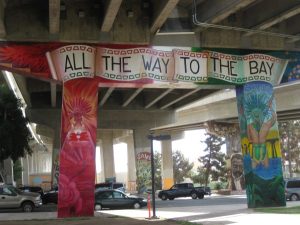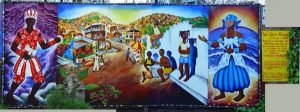The Wonders of Chicano Art
My name is Austin Munchbach and my portfolio is called “The Wonders of Chicano Art”. The licensing I will be using is CC BY 4.0.
Introduction
Out of all the modules and topics covered this past semester, one really stuck out to me, and that was Chicano Art. Chicano Art really touched my heart because of the many themes and hidden messages behind every single mural that was painted by a citizen in the community. Chicano Art is used to bring cultures and communities closer together by using creativeness, and it is also an example of an art form for people to see all the metanarratives behind the thousands of art-works created. In this portfolio, I will be explaining the environmental impacts and themes of three significant pieces of Chicano Art.
Theme: Migration of Culture
Throughout all of Chicano History, many of their people were faced with problems of having to leave their original homelands that they have already resided in. Constantly, citizens from these cities had to move to new locations because of higher ranked individuals and groups removing them. During this process, Chicano citizens were seeking peace and unity, and one way they found they could express these emotions was through art. They decided to design and create large murals around large urban cities, and these were for multiple reasons. First, it was to express their feelings and express their creativity that they have held on to all along. Next, they wanted to leave a mark of their culture for many to see, and what better spot than in large urban environments. Tens of thousands of people commute to work every single day and along the way they notice these vibrant murals spreading all along the city. This raises awareness for all Chicano citizens. Also, painting these murals marks their territory along their difficult journey. Putting up this artwork city-wide makes it hard for higher-ranked individuals to evict these Chicano residents because they are giving them a reason to stay.
There are other environmental impacts that Chicano Art has. First, it is bringing advertisement to the agricultural culture. Many of the Chicano citizens have a strong passion for being generous and helping others, and a way they express this generosity is by agriculture. They plant certain foods to grow, and eventually distribute the food out to the less-fortunate. Spreading these murals and painting nationwide can grow awareness of Chicano culture and bring positive effects to all the citizens and supporters.
Theme: Finding True Identity
The three murals below may seem different in their physical appearance, but deep behind each painting is a common theme between the artists: finding their true identity. Each image and mural was a solution to helping someone find who they truly are. From the beginning of the Chicano culture, they were faced with many difficult challenges. A majority of these challenges originated from the oppression of their demographics, such as social class race. These challenges took a large emotional toll on the Chicano people. They disassociated themselves from their purpose and their ambitions in life. Being evicted and relocated to multiple cities nationwide was also a problem in finding their true identity, but the oppression was really the main reason. In order to get closer and closer to finding their true selves, they designed murals all along the southwest region, such as San Diego and San Francisco. These bright and vibrant colors brought light to all the souls of the artists and others, and they eventually found a passion.
I chose these murals to add to my portfolio because of the heartfelt meaning behind every single piece of artwork. It is important to me because I believe I am a super passionate individual and I can strongly relate to these artists of the Chicano culture.
“All the Way to the Bay mural in Chicano Park” by Rpotance is licensed under CC BY-SA 4.0.

This first image is a mural painted under a bridge inside Chicano Park, located in San Diego. This colorful and creative painting was designed by a man named Victor Ochoa. The name of the mural is “All the Way to the Bay”, and this translates to “Hasta La Bahia”. The reason for this artwork was the challenge Ochoa’s community faced when trying to establish a strong and wealthy community in San Diego. This time period of perseverance for a community lasted from the 1970s all the way to the 1980s. The culture’s persistence in saving their community paid off as the livelihood of Chicano Park still stands today in 2023, going into 2024.
This mural accompanies many others across the entire city of San Diego. All other artworks along bridges and in alleyways have the same message and theme: keep the culture alive. All these designs went up around the same time, as this stretch of time was very critical to the citizens within the culture.
Ochoa was a very admired artist as he has not stopped designing artwork throughout San Diego. In 1985, Ochoa finished a mural by the name of “Revolucion Mexicana”. His most recent mural, finished in 2022, was a token of appreciation to the Mexican American culture. As you can see Ochoa is a very passionate individual and he is not done yet.
“Mural on Mission @ 24th – San Francisco” by Franco Folini is licensed under CC BY-SA 2.0.

This mural is one of thousands that are spread throughout the city of San Francisco, California. These murals can be found anywhere in the city but a large majority are fixed between 24th and 25th street. The first murals went up in the early 1970s. These murals were designed and painted by artists collaborating with a non-profit organization called Precita Eyes. Precita Eyes accept painting requests from many companies within the area to animate the streets where the businesses are located. These murals can benefit both businesses and individual artists. These innovative and vibrant murals help businesses out by attracting customers with their bright color schemes, and the artists’ benefits are being able to express themselves through their artwork. Businesses make more money and artists are able to find their true selves, so it is a win-win situation in the city of San Francisco. The first paintings that went up in the 1970s have experienced bad weather and, overall, fading. This doesn’t stop people appreciating the beauty of such outstanding artwork, and people can see the originality of these murals.
“Tattoo_Black & tattoo(2007) – Chicano Style” by Apro Lee is licensed under CC BY 2.0.

This type of Chicano art is definitely the most altered from the previous examples above. Instead of these bright colorful murals, we switched to dull, tattoos. There were no original, individual artists that started this movement. This rise of the Chicano clowns became very popular in the 1990s and carried into the early 2000s. These tattoos of these clowns symbolize the challenges of the gang lifestyle within the Mexican-American culture. People decided to start getting tattoos of these Chicano clowns because it became part of their life. They became passionate and emotional with the people they were around because they experienced the lows-and-highs of being in a gang together. This wraps back to the theme of “finding your true identity” because now, ex-gang members are trying to start a new life, and this includes escaping the old gang lifestyle and finding a better lifestyle. Putting a permanent piece of art on your body is the ultimate test of loyalty within Mexican-American culture.
Chicano clowns also have an extended interpretation of “Laugh now, cry later.” This is a harsh meaning as it means “do this now but you aren’t able to show emotions, and after you can soak it all in.” This was a sign of toughness in the community and only certain people could relate to “laugh now, cry later”, such as gang members.
Application
Chicano Art is so vital to understanding society because of the variety of themes someone can draw from a singular mural. One mural can have hundreds of interpretations and that is why they are so special. Also, every single mural painted by a Chicano artist tells a story that could explain why a society functions like it does. For example, the murals in Chicano Park tell the story about the perseverance of a community constantly being evicted from their land and still finding a way to portray their passion and creativity. The Chicano Clown tattoos tell a story about struggling with gang violence and trying to find a new identity, while improving your current lifestyle. Finally, the murals that fill the streets of San Francisco tell a story about how a community is united through artwork, and how everyone can feel connected by just reaching out to one other, in this case reaching out to Precita Eyes. You are able to understand a society and a community by just taking a glance at a piece of artwork, because of how much meaning can be interpreted from such fabulous artwork.
Firstly, Ochoa provides an excellent way of understanding his topic. His struggle was finding a permanent place to make home, and his solution was making murals around the area he was in. These murals raised awareness for his problems so people couldn’t help but realize that this culture was struggling and they had to do something about it.
Next, the Chicano Clowns being tattooed on someone’s body is definitely an unconventional way to understand what is being portrayed. Putting a piece of artwork on your body permanently is a huge risk that only some people are willing to take. This is why the clowns are a sign of loyalty, because certain individuals are willing to put the artwork on their body.
Finally, the Mission Murals in San Francisco is a distinctive way of portraying a topic, because thousands of people see it every day. Business men and locals will see it first, but that doesn’t account for the thousands of tourists these murals attract every month. This is an easy way to advertise emotions, or a theme, and it definitely works, as Chicano Art is spreading nationwide.
Websites Used
https://en.wikipedia.org/wiki/Chicana_art
https://www.sandiegouniontribune.com/guides/story/2023-04-19/chicano-park-guide-barrio-logan#:~:text=One%20of%20the%20most%20well,to%20the%20San%20Diego%20Bay.
https://www.sftourismtips.com/mission-district-murals.html
Media Attributions
- AllTheWayInTheBay
- missionmurak
- clown tattoo

